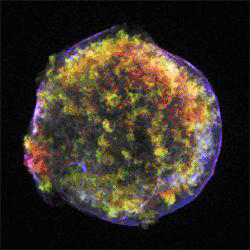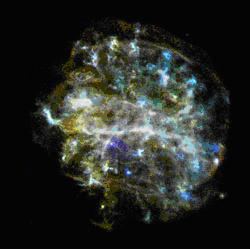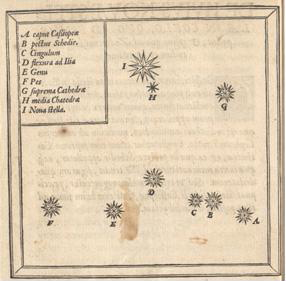Purpose: To determine types of supernova events by examining Chandra X-ray Observatory images of supernova remnants (SNRs) and by identifying the elements in their energy spectra.
Tycho's Supernova Remnant
In the year 1572, the Danish astronomer Tycho Brahe observed and studied the sudden appearance of a bright "new star" in the direction of the constellation Cassiopeia. Now known as Tycho's supernova remnant, the event created a sensation in Tycho's time because until then stars were thought to be unchanging. Tycho's observations of this event marked the beginning of the study of astronomy as a science. This object is a Type Ia event - the thermonuclear destruction of a white dwarf. Information about this object is located at http://chandra.harvard.edu/press/05_releases/press_092205.html
SNR G292.0+1.8
The Type II core collapse of a massive star that produced this supernova remnant ~1600 years ago is located in the direction of the constellation Centaurus. SNR G292.0+1.8 is interesting because it is one of only three oxygen-rich remnants and one of the primary sources of the heavy elements necessary to form planets and people. Although considered a "textbook" case of a supernova remnant, the intricate structure shown here reveals a few surprises. Information about this object is located at http://chandra.harvard.edu/photo/2007/g292/
Tycho's Supernova Remnant (Type Ia) and SNR G292.0+1.8 (Type II) are representative of the two supernova types. Follow the procedure below to analyze their spectra and determine the elements present in the remnants and their relative abundances. The same procedure will be used to study other remnants, compare the results to Tycho and SNR G292.0+1.8, and determine if they are Type II or Type Ia supernova events.
Procedure:
1. Examine Figure 6, the bremsstrahlung spectrum of Tycho's SNR.
2. On Figure 6, number the emission lines (peaks) you have decided to identify.
3. To get the energy of each emission line, measure the distance between 1 and 2 keV to the nearest tenth of a centimeter (cm). This gives a scale in cm/keV. Measure the distance in cm (with as much precision as possible) from 1 keV to the center of each peak (X- ray emission line). Make this distance negative if the peak is before 1 KeV and positive if it is after 1 keV. Record in the data table.
4. Divide the distance to each peak (cm) by your scale (cm/keV) and add to 1 KeV to get the energy (keV) of each emission line. Record in the data table.
1 KeV + [(d in cm)/(scale in cm/KeV)]
5. Identify the elements for each X-ray emission line/peak using Table 1. If you have lines whose energy is not close to that of one of the elements in the chart, leave those lines unidentified. Record in the data table.
6. Repeat steps #1-5 for Figure 7, the bremsstrahlung spectrum of SNR G292.0+1.8.
Table 1. Energies of X-ray Emission Lines
|
|
|
||||||||||||||||||||||||||||||||||||||||||||||||||||||||||||
|
|
|
Data:
Tycho's SNR (Type Ia)Distance from 1 KeV to 2 KeV: 1 Kev = ________ cm
# of |
distance |
Energy of |
chemical symbol |
SNR G292.0+1.8 SNR (Type II)
Distance from 1 KeV to 2 KeV: 1 Kev = ________ cm # of |
distance |
Energy of |
chemical symbol |
Conclusions and Analysis:
1. What are the similarities and differences between these two spectra?
2. From your analysis of Tycho's SNR and SNR G292.0+1.8, what elements are more predominant in a Type Ia supernova? Which are more predominant in a Type II? Are there elements present in one that are not in another?
3. Explain how you might be able to classify a supernova event as type Ia or type II from its spectrum based on your observations of Tycho's SNR and SNR G292.0+1.8. Sometimes, due to interstellar absorption, emission lines less than 1.5 KeV are not seen. How could this affect your classification of a supernova remnant?
Extensions:
1. Analyze the spectra of any three of the following SNRs using the same procedure as Tycho's SNR and G292.0+1.8. Construct your own data tables.
- a. Figure 8. W49B
- b. Figure 9. Kepler's SNR
- c. Figure 10. SNR 0103-72.6
- d. Figure 11. DEM L71
- e. Figure 12. Cas A
2. From your analyses, classify these SNR by type. What is the basis for your conclusions? How sure are you of your classifications? What features of the spectra helped with your classifications? What features made it difficult to classify these SNR?
3. Look up these supernovas in the Chandra Supernova Photo Album. How do your results compare with the information in the Photo Album? http://chandra.harvard.edu/photo/category/snr.html
Figure 6. Bremsstrahlung Spectrum of Tycho's SNR

Figure 7. Bremsstrahlung Spectrum of G292.0+1.8

Figure 8. Bremsstrahlung Spectrum of W49B

Figure 9. Bremsstrahlung Spectrum of Kepler's SNR

Figure 10. Bremsstrahlung Spectrum of SNR 0103-72.6

Figure 11. Bremsstrahlung Spectrum of DEM L71

Figure 12. Bremsstrahlung Spectrum of Cas A







